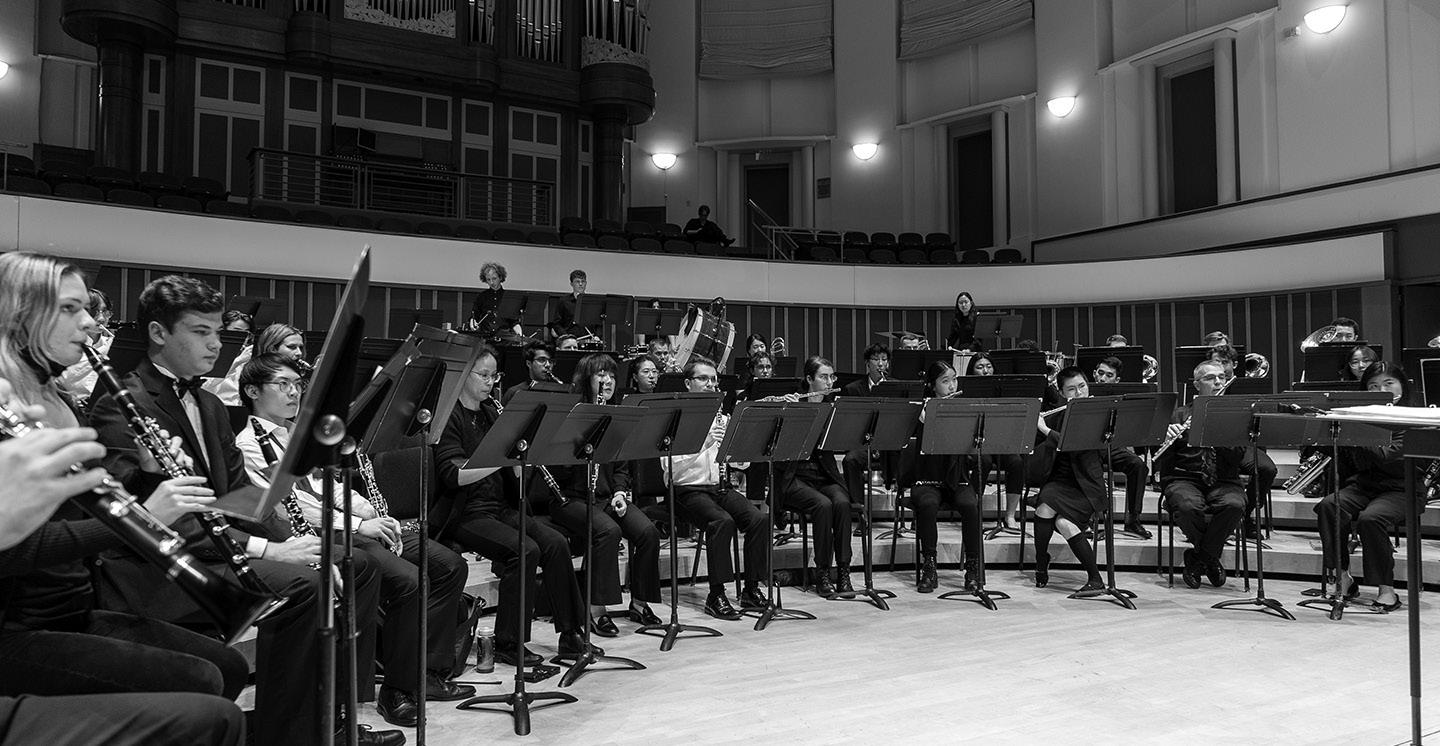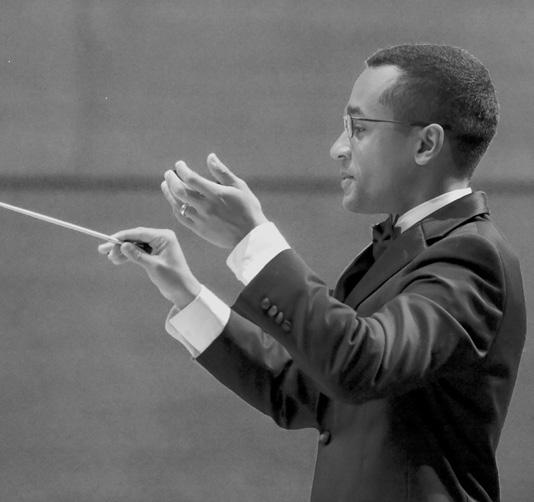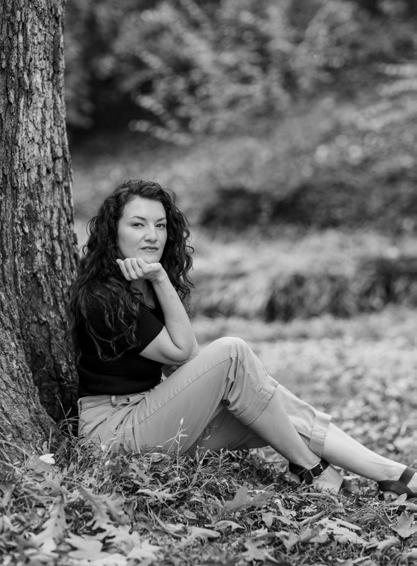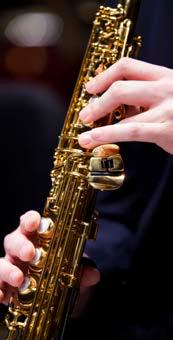








Welcome to the Schwartz Center for Performing Arts. Please turn off all electronic devices. Photography, recording, or digital capture of this concert is not permitted.
404.727.5050 | schwartz.emory.edu | boxoffice@emory.edu
Audience Information
The Schwartz Center welcomes a volunteer usher corps of about 40 members each year. Visit schwartz.emory.edu/volunteer or call 404.727.6640 for ushering opportunities.
The Schwartz Center is committed to providing performances and facilities accessible to all. Please direct accommodation requests to the Schwartz Center Box Office at 404.727.5050, or by email at boxoffice@emory.edu.
The Schwartz Center wishes to gratefully acknowledge the generous ongoing support of Donna and Marvin Schwartz.

Michael Kobito, conductor
Sunday, March 2, 2025, 7:00 p.m.
Emerson Concert Hall
Schwartz Center for Performing Arts
The Hounds of Spring Alfred Reed (1921–2005)
Children’s March Percy Aldridge Grainger (1882–1961)
Rondino Ludwig van Beethoven (1770–1827)
Goodnight Moon Eric Whitacre (b. 1970)
Bethany Mamola, soprano
With Heart and Voice
The Fairest of the Fair
David Gillingham (b. 1947)
John Philip Sousa (1854–1932)
Michael Kobito is a music educator, conductor, and trumpeter from Cartersville, Georgia. He serves as the conductor of the Emory Wind Ensemble and associate conductor of Tara Winds.

Prior to his appointment at Emory University, Kobito served as director of bands at Woodland High School in Cartersville. During his tenure as director, the band performed at multiple national events including the Cherry Blossom Festival Parade in Washington, D.C., the Georgia Music Educators Association In-Service Conference, the Southeastern United States Honor Band Festival, the Macy’s Thanksgiving Day Parade in New York City, University of Georgia’s Janfest Honor Band Festival, and most recently in the 2023 London New Year’s Day Parade. He also taught AP Music Theory, where his students earned a 100 percent pass rate on the AP exam.
As a conductor and trumpeter, Kobito is an active musician, performing regularly around metro-Atlanta in Tara Winds and the Georgia Brass Band. As a conductor of Tara Winds, the band was invited to perform in France at the 2023 Festival des Anches d’Azur in La CroixValmer, and locally at the 2024 GMEA In-Service Conference. Additionally, with these groups, Kobito has performed at multiple honor invitational events including the Midwest Clinic in Chicago and the North American Brass Band Competition in Fort Wayne, Indiana. He has served as a guest conductor for the Georgia Brass Band and has been the clinician for multiple honor bands around Georgia and the United States. He has been the recipient of the National Band Association Citation of Excellence for his work with the Woodland Band and Tara Winds on five occasions.
Kobito is a dedicated advocate for education, having served as an ambassador for educators in the state as the 2023 Georgia Teacher of the Year. He is an active keynote speaker, clinician, and panelist on topics around best education practices and pedagogy, teacher recruitment and retention, and the future of education.
The Hounds of Spring was inspired by the poem Atalanta in Calydon by Algernon Charles Swinburne. Reed quotes it and describes the inspiration it gave him in his own program notes:
“When the hounds of spring are in winter’s traces,” a magical picture of young love in springtime forms the basis for the present purely musical setting in traditional three-part overture form, of this lovely paean. It is an attempt to capture the twin elements of the poem, exuberant youthful gaiety and the sweetness of tender love, in an appropriate musical texture.
The Hounds of Spring was commissioned by, and dedicated to, the John L. Forster Secondary School Concert Band of Windsor, Ontario, Canada, and its director, Gerald A. N. Brown. The world premiere was in Windsor on May 8, 1980, conducted by the composer.
—Program Note by Andy Pease for Wind Band Literature
Children’s March was scored for band by Grainger in 1919 from a piano solo which he had composed between 1916 and 1918. The band arrangement was begun in 1918 while the composer was a member of the United States Coast Artillery Band and was written to take advantage of that band’s instrumentation. Generally accepted as the first band composition utilizing the piano, the march features the woodwinds— especially the low reeds—during most of its seven-minute duration. From the introduction to the end, the folk-like melodies make it difficult for the listener to realize that the work was original with Grainger. It was first performed by the Goldman Band on June 6, 1919 with the composer conducting and Ralph Leopold at the piano.
Like many of Grainger’s works, the march demonstrates both the fierceness and the tenderness of the composer’s personality. It was dedicated to “my playmate beyond the hills,” believed to be Karen Holton, a Scandinavian beauty with whom the composer corresponded for eight years but did not marry because of his mother’s jealousy. In 1953, forty-eight years after they first met, they saw each other for the last time in Denmark where Grainger had gone for a cancer operation to be performed by Dr. Fai Holton, Karen’s brother.
—Program note from Program Notes for Band
Rondino
This modest piece shares with Beethoven’s more substantial wind octet the year of composition, key, and scoring (pairs of oboes, clarinets, horns, and bassoons), and, in fact, was probably composed originally as an alternate finale for that work. It’s one of many pieces Beethoven composed as “table music” for the court of Maximilian Franz, Elector of Cologne, in whose service he had been since 1784.
In contrast to the energetic octet, this is a mellower work, an andante that begins with a spacious, horn-flavored melody serving as a refrain. It makes two varied and embellished returns, the first with tender filigrees from the non-melody instruments, and the second with lightly witty little flourishes from the oboes and clarinets. In between come two minor-mode episodes, gentle nocturnes; the first features the clarinet in a plaintive little aria, and the second is a substantial duet for the horns. The coda fades into the distance, but not before requiring the horns to play an extended passage alternately unmuted and muted, which must have been a challenge to the players of the time, who had to handstop some notes on their valveless instruments.
—Program note by James Reel for the Eastman Wind Orchestra
Over the past few years, I must have read Goodnight Moon to my son a thousand times—maybe more. Somewhere around reading number 500, I began hearing little musical fragments as I read, and over time those fragments began to blossom into a simple, sweet lullaby. I knew it was a long shot, but I asked my manager, Claire Long, to contact Harper Collins and see if they would allow the text to be set to music. To my surprise and delight, they agreed—the first time they had ever allowed Goodnight Moon to be used in such a way.
I composed the piece relatively quickly, originally setting the text for harp, string orchestra, and my son’s mother, soprano Hila Plitmann. I later arranged Goodnight Moon for choir and piano. More recently, my dear friend Verena Mösenbichler-Bryant arranged the piece for wind ensemble and soloist.
The melody of Goodnight Moon will forever make me think of those quiet nights, reading my son to sleep.
—Program note by composer Eric Whitacre
With Heart and Voice was commissioned by Apple Valley High School Bands, Scott A. Jones, director (Apple Valley, Minnesota), to commemorate the twenty-fifth year of the high school. Apple Valley High School’s strong commitment to the arts was a major factor in my decision to take on this commission. After visiting the school in December of 2000 and meeting many of the students, faculty, and administrators, I became greatly inspired.
Thematically, the work is based on the Apple Valley High School Alma Mater, an old Spanish hymn which has made its way into most church hymnals under the name of Come, Christians, Join to Sing. It is perhaps fate that this hymn, a particular favorite of mine, happens to be the tune used for the Alma Mater. Christian Henry Bateman wrote the words for the hymn in 1843, and the first verse contains the line, “Let all, with heart and voice, before the throne rejoice.” Hence, the title, With Heart and Voice. What better way to celebrate twenty-five years of this great school than with our hearts and voices? The “voice” in this case is the music, and the “heart” is the emotion that the music renders in celebration.
Although the work is largely celebratory in nature, it begins with a feeling of reticence and apprehension, much like the beginnings of Apple Valley High School. It was at one time only an idea or perhaps a sketch in the mind of the architect. Small fragments of the Alma Mater are heard in the opening moments of the piece. The piece gains momentum, texture, and volume in this opening section, culminating in a dramatic statement of the first four notes of the theme. A calmness follows and a lyrical flute solo enters. This new material represents the uniqueness of the “mission” of a new school which will have roots in academic excellence and commitment to the visual and performing arts. The euphonium echoes the flute and soon more instruments join in, and the section culminates with a dramatic fanfare. This is followed by a transitional section with much more dissonance rhythmic activity, equated to the challenge of bringing life to this new school. A glorious statement of the Alma Mater follows, signifying the dedication of Apple Valley. The ensuing section begins as a fugue with underlying unsettling rhythmic activity in the percussion. The section becomes frantic and desperate, but soon subsides into peacefulness. The peacefulness is stated by the marriage of the Alma Mater theme and the “Mission” theme . . . after all, for the high school to survive, it must never forget its mission. An extended finale follows, which celebrates both themes in playful, joyful, and dramatic exuberance.
—Program note from the score
The Fairest of the Fair is generally regarded as one of Sousa’s finest and most melodic marches, and its inspiration came from the sight of a pretty girl with whom he was not even acquainted. It was an immediate success and has remained one of his most popular compositions. It stands out as one of the finest examples of the application of pleasing melodies to the restrictive framework of a military march.
The Boston Food Fair was an annual exposition and music jubilee held by the Boston Retail Grocers’ Association. The Sousa Band was the main musical attraction for several seasons, so the creation of a new march honoring the sponsors of the 1908 Boston Food Fair was the natural outgrowth of a pleasant business relationship. In fairs before 1908, Sousa had been impressed by the beauty and charm of one particular young lady who was the center of attention of the displays in which she was employed. He made a mental note that he would someday transfer his impressions of her into music. When the invitation came for the Sousa Band to play a twenty-day engagement in 1908, he wrote this march. Remembering the comely girl, he entitled the new march The Fairest of the Fair.
Nearly three months before the fair, Sousa had completed a sketch of the march for the publisher. He also wrote out a full conductor’s score from which the individual band parts were to have been extracted. The band had just finished an engagement the night before the fair’s opening and had boarded a sleeper train for Boston. Louis Morris, the band’s copyist, was helping the librarian sort music for the first concert, and he discovered that the most important piece on the program—The Fairest of the Fair—had not been prepared. The librarian, whose job it had been to prepare the parts, went into a panic.
Morris worked the entire night, and the parts were nearly finished when dawn broke. Both were greatly surprised by the appearance of Sousa, who had arisen to take his early morning walk. When asked about the frenzied activity, they had no choice but to tell what had happened. After recognizing Morris’s extraordinary effort and remarking that it was saving the band from considerable embarrassment, he instructed him to complete his work and to take a well-deserved rest, even if it meant sleeping through the first concert. With no one the wiser, Louis Morris was asleep in his hotel as The Fairest of the Fair was played for the first time on September 28, 1908. Sousa did not mention the subject again, but Morris found an extra fifty dollars in his next pay envelope—the equivalent of two weeks’ salary.
—Program note from John Philip Sousa: A Descriptive Catalog of His Works
The Emory Wind Ensemble (EWE) is a nationally recognized organization dedicated to performing wind literature of the highest caliber while nurturing individual artistic excellence within an ensemble setting. Membership is determined by audition each fall. Concert programming comprises a wide variety of styles, forms, and genres from several centuries of compositional practice, designed to provide comprehensive exposure to the masterpieces for winds and percussion from the Renaissance period through the modern era. A flexible instrumentation is employed with predominantly one player per part, giving students the opportunity to experience true wind ensemble performance practice.
The EWE performs two concerts each semester, regularly participates in world premieres of new music, tours the United States and abroad, and is a national leader in the commissioning of new music, including works by Warren Benson, Steven Bryant, Stephen Paulus, Bruce Broughton, Jennifer Higdon, Libby Larsen, John Mackey, David Maslanka, Jonathan Newman, and many others. In 2017, the ensemble was showcased by the College Band Director’s National Association among its peer institutions with a citation for musical excellence at the “Small Band Showcase,” presented at the Association’s National Conference in Kansas City.
The EWE’s recent collaborations include performances with the Emory University Chorus; the Emory Dance Company; Emory’s Mary Emerson Professor of Piano William Ransom; Chris Martin, principal trumpet of the New York Philharmonic; Stuart Stephenson, principal trumpet of the Atlanta Symphony Orchestra; Joe Alessi, principal trombone of the New York Philharmonic; Adam Frey, international euphonium solo artist; and Grammy Award–winning solo clarinetist Richard Stoltzman.
The EWE has performed concert tours of Munich, Salzburg, Innsbruck, Lucerne, Graz, Prague, Vienna, and Greece. Additionally, it has performed at the Georgia Music Educators Association (GMEA) State Convention in Savannah, Georgia; at the Southern Division College Band Directors National Association Conference (CBDNA); and for various events on Emory’s campus, including the inauguration of James Wagner as president of Emory University. Most recently, a brass ensemble made up of EWE members performed live during a national broadcast by the National Basketball Association. The EWE is recorded on the NAXOS and Centaur music labels.
Sections listed alphabetically
Flute / Piccolo
Aricka Boosa
Hannah Huang
Aldo Rios
Sophia Song
Rosie Wu
Oboe / English Horn
Sissi Chen
Amber Ford
Zachary Kant
Zlang Zhang
Clarinet
Kayla Bak
Jamie Eck
Ian Moon
Joe van Duyn
Nick Wandrick
Bass Clarinet
Nicole Bring
Sam Chernoff
Saxophone
Abby Balson
Martin Lin
Andy Nguyen
Jonathan Uhlengerg
Bassoon
Nicole McGill
Horn
Aditya Dutta
Josh Lee
Justin Wang
Trumpet
Ian LaBreck
Natalie Park
William Sun
Austin Watkinson
Trombone / Bass Trombone
Tim Brewer
Chris Cheong
Ethan Hsuing
Jakob Ostheimer
Euphonium
Tyler Edwards
Tuba
Michael Amsel
Anna Gayler
Piano
Jonathan Lou
Percussion
Nellie Gregg
Meredith Liu
Aiden Neuser
Mingyu Zhang
Sunny Zheng

Soprano Bethany Grace Mamola has charmed audiences with her stage presence and warm vocal timbre. The Cleveland Plain Dealer praised her with “ . . . the most beautiful singing, whose Carolina was as disarming in characterization as it was expressive in vocal shading.” Arts Atlanta wrote that Mamola “was that rare talent who commands not only the virtuosity of a seasoned operatic vocalist but also the stage presence and acting prowess necessary to truly embody the character she presents,” and that “Mamola was a captivating presence not only for her extraordinary dynamic range but also the graceful ease with which she commanded it.” The Cleveland Classical said she was “a delight to hear and see. Her casual, yet precise stage demeanor and astute vocal talent made for a wonderfully clear vocal interpretation that rang throughout the hall.” Mamola has been a featured soloist with the National Repertory Orchestra Festival in Colorado, the DeKalb Symphony Orchestra, the Sausalito Song Society, the McKinney Philharmonic, the River Cities Symphony Orchestra, the Amelia Island Chamber Music Festival, and was the featured soprano soloist with the UTRGV Symphony Chorus in their 2019 performances of Handel’s Messiah. She made her directorial debut as creative director of Try Me at the Winspear Opera House in conjunction with ATT Performing Arts Elevator Project performed at the Winspear Opera House in Dallas, Texas. Mamola’s recent performances include an appearance with John’s Creek Symphony Orchestra in December 2024, and the Highland Cashiers Chamber Festival this summer. Mamola holds a DMA in voice from the University of North Texas, a Master of Music from the Cleveland Institute of Music, and a Bachelor of Music from the University of the Pacific’s Conservatory of Music. Mamola is an enthusiastic educator in voice and opera performance and the Director of Vocal Studies at Emory University.
Violin
Justin Bruns •
Jay Christy •
Emily Daggett Smith H
Jessica Wu H
Viola
Yinzi Kong
Paul Murphy •
Joseph Skerik H
Clarinet
Jesse McCandless •
Justin Stanley
Bassoon
Anthony Georgeson •
Shelly Unger
Trumpet
Mark Maliniak •
Michael Tiscione •
Trombone
Ed Nicholson s
Nathan Zgonc •
Percussion
Sarah Dietrich
Scott Pollard
Mark Yancich •
Euphonium
Adam Frey
Flute
Christina Smith • Jim Zellers s
Oboe
Emily Brebach •
Sasha Shatalova Prior
Tuba
Michael Moore •
Stephen Crist, Chair
Saxophone
Gary Paulo
Horn
Jason Eklund s
Ryan Little •
Harp
Elisabeth Remy •
Cello
Karen Freer •
Roee Harran
Guang Wang H
Bass
Michael Kurth •
Joe McFadden •
• Atlanta Symphony Orchestra s Atlanta Opera Orchestra H Vega Quartet
Meredith Schweig, Director of Undergraduate Studies
Paul Bhasin, Director of Undergraduate Research
Martha Shockey, Senior Secretary
Kathy Summers, Academic Department Administrator
Magdalena Shumanova, Academic Services Program Coordinator
Simone McGaw Evans, Program Coordinator
Many concerts at Emory are free to attend. Visit music.emory.edu or schwartz.emory.edu to view complete event information. If a ticket is required for attendance, prices are indicated in the listings below in the following order: Full price/Emory student price (unless otherwise noted as the price for all students).
Thursday, March 6, 8:00 p.m., Emory University Symphony Orchestra, Schwartz Center, Emerson Concert Hall
Friday, March 14 and Saturday, March 15, 8:00 p.m., Pathways, Atlanta
Master Chorale, Schwartz Center, Emerson Concert Hall, $42/$10 (all students)
Wednesday, March 19, 6:00 p.m. and Thursday, March 20, 2:30 p.m., Vocal Symposium, Performing Arts Studio
Thursday, March 20, 8:00 p.m., Emory Department of Music: An Evening with Music of Philip Glass, Performing Arts Studio
Friday, March 21, 8:00 p.m., New York Voices, Candler Concert Series, Schwartz Center, Emerson Concert Hall, $40/$10
Saturday, March 22, 8:00 p.m., The Old and the New, ECMSA: Emerson Series Waits Chamber Music Concert, Cannon Chapel
Friday, March 28, noon, The Rites of Spring, ECMSA: Cooke Noontime Series, Schwartz Center, Emerson Concert Hall
Friday, March 28, 8:00 p.m., Caroline Owen, piano, Artist Affiliate Recital, Schwartz Center, Emerson Concert Hall
Sunday, March 30, 4:00 p.m., Emory Concerto and Aria Competition, Schwartz Center, Emerson Concert Hall
Thursday, April 3, 6:30 p.m., Jazz on the Green, Patterson Green
Sunday, April 6, 7:00 p.m., Emory Collaborative Piano, Performing Arts Studio
Friday, April 11, 8:00 p.m., Imani Winds and Boston Brass, Candler Concert Series, Schwartz Center, Emerson Concert Hall, $40/$10
Sunday, April 13, 2:00 p.m., Emory Chamber Ensembles, Schwartz Center, Emerson Concert Hall
Sunday, April 13, 4:00 p.m., Atlanta’s Young Artists, ECMSA: Family Series, Carlos Museum, Ackerman Hall
Sunday, April 13, 7:00 p.m., Emory Concert Choir, Schwartz Center, Emerson Concert Hall
Tuesday, April 15, 8:00 p.m., Emory Big Band with Special Guest Patrick Langham, Schwartz Center, Emerson Concert Hall
Thursday, April 17, 8:00 p.m., Emory Wind Ensemble Schwartz Center, Emerson Concert Hall
Friday, April 18, noon, Vega Quartet Carnegie Hall Preview, ECMSA: Cooke Noontime Series, Carlos Museum, Ackerman Hall, free, registration required
Saturday, April 19, 8:00 p.m., StageWorks 2025, Performing Arts Studio
Tuesday, April 22, 8:00 p.m., Spring Composition Showcase, Performing Arts Studio
Friday, April 25 and Saturday, April 26, 8:00 p.m., Emory University Symphony Orchestra and University Chorus, Schwartz Center, Emerson Concert Hall
Friday, May 2 and Saturday, May 3, 8:00 p.m., An Evening with Mozart— Coronation Mass and Requiem, Atlanta Master Chorale, Schwartz Center, Emerson Concert Hall, $45/$10 (all students), tickets required
Sunday, May 4, 4:00 p.m., Jon Kimura Parker, piano, ECMSA: Emerson Series, Schwartz Center, Emerson Concert Hall
Wednesday, May 7, 8:00 p.m., Emory Youth Symphony Orchestra, Schwartz Center, Emerson Concert Hall
Sunday, May 11, 1:30 p.m., Cherry Emerson Memorial Alumni Concert, ECMSA: Emerson Series, Schwartz Center, Emerson Concert Hall


Music at Emory brings together students, faculty, and world-class artists to create an exciting and innovative season of performances, lectures, workshops, and master classes. With more than 150 events each year across multiple Emory venues, audiences experience a wide variety of musical offerings.
We hope you enjoy sampling an assortment of work from our student ensembles, community youth ensembles, artists in residence, professional faculty, up-and-coming prodigies, and virtuosos from around the world.
music.emory.edu



